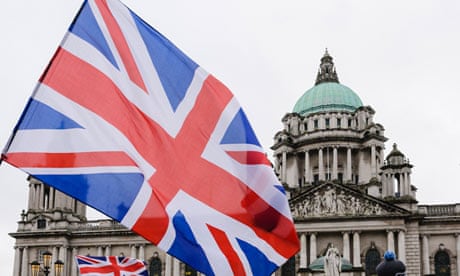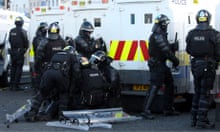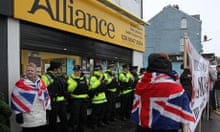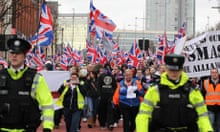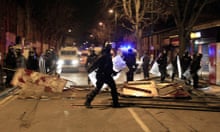This article is the subject of a legal complaint.
In her pink tracksuit and black baseball cap, Becky Rowan is a typical "footsoldier" of the Ulster loyalist street protesters currently engaged in a bitter war over when the union flag can fly atop Belfast City Hall.
Standing amid a forest of flags at the top of Royal Avenue during the latest protest, the 19-year-old student from the loyalist Taughmonagh estate in south Belfast articulates the anger and fear of a younger generation of working-class, urban Protestants who were not supposed to relive the sectarian struggles of the past.
"I've been to every protest since they took that flag down," she said, gesturing towards the green-domed roof of the Victorian City Hall where the flag used to fly every day of the year. "We are the United Kingdom, it's our flag. For it to be taken down is removing British rights. Equality has gone out the window for Protestants in this city a long time ago," she said.
Clashes on Saturday left 16 police officers injured as they tried to quell the violence. At one point there was hand-to-hand fighting between Catholic residents of east Belfast's Short Strand area and loyalist marchers returning from the city centre. Riot police fired at least four plastic bullets.
Asked about the disorder and rioting that has resulted in more than 100 arrests and dozens more injuries to police, Rowan said: "I understand why [it's happening] although I personally think it's wrong. The main point about the violence is the police and the way so many of them come to the protests, as if they want trouble. If the police come in those numbers then they are provoking it. It's a disgrace what is going on."
As she denounces the police – in language once used by young republicans alienated from the security forces during the Troubles – a young man in a Rangers tracksuit top waves a placard stating: "End PSNI Brutality Now."
Rowan wasn't even at primary school when the IRA and loyalist paramilitary ceasefires were declared in 1994. So why does someone from her generation, supposedly enjoying nearly two decades of relative peace, choose to join the mass demonstrations and disruptions that have paralysed Belfast and cost an estimated £15m loss of revenue in retail trade since the protests began last December?
"It's not just about the flag any more. In my opinion it is about so much more, such as giving Sinn Féin everything they wanted. They are trying to take away everything that is British in this society. Why should they get everything they want? I personally don't think the flag will go up but I really hope it does. We are used to fighting in a corner and losing, but it's time we took a stand," Rowan said.
Jamie from Magherafelt, Co Derry, said he had travelled from the rural town every week to attend the rally in Belfast. He refused to give his full name, claiming that he lived in a republican-dominated area and feared being attacked.
The 20-year-old said: "It's also about demonising the Protestant community, portraying us all as thugs. I am joining these protests because there is an attack in a cultural war against our community. We are told, 'You can't parade here', 'You can't play certain songs' and now, 'You have to take the flag down'. We can't sit back and let our Britishness be stripped away any more."
He was also scathing about the Democratic Unionist party, the major force in unionism in the Northern Ireland assembly. "They are letting things like this happen in Belfast and are not giving real representation to people like me."
Yet any notion that a new unionist political movement is emerging from these month-long protests appears remote. The divisions within the broad unionist family were laid bare at the front gates of City Hall, when Jim Wilson, a loyalist community worker from east Belfast, got into an altercation with unionist victims' campaigner Willie Frazer. Wilson accused Frazer of "leading us down the road that the IRA wants us to go" in terms of demonstrations linked to the flag change policy. Frazer accused Wilson and fellow loyalists of 15 years of failure since various unionist groups backed the Good Friday agreement peace deal.
On a march from the heart of loyalist east Belfast, where much of the violence of the past 10 days has been concentrated, most of those heading towards City Hall were between their early teens and 20s.
Robert Graham, 19, from Bangor, Co Down, said this was his third time marching in from the east of the city to central Belfast. "I want to do my bit to protect our British identity in Ulster," he said, standing beside a relative near a banner denouncing the decision to change the council's flag-flying policy and watched by a line of police officers, some carrying batons.
Pressed on how changing that policy to 17 designated days could somehow break the union between Northern Ireland and Great Britain, Graham said: "It's a bit-by-bit thing. Each little bit of Britishness being eroded, constantly. I have friends from Bangor who have served out in Afghanistan in the British army and they feel exactly the same about the flag."
Not everyone attending the protest shares the existential fears of a younger generation of loyalists who did not experience the scale of death and destruction that occurred during the Troubles. Veteran loyalist activist Raymond Lavery was nine when the conflict erupted in 1969. Lavery said what was desperately needed was a political education programme to convince younger loyalists that their fears may not be realised.
"I remember gun battles in my street in 1970 when we had to hide under the stairs to be safe. These young people out here today didn't live though any of that; they can't imagine what it was really like.
"The worst danger is that one of these young people out demonstrating or rioting gets run down by a police Land Rover and is killed or injured. What is important here is that this generation not only get a better formal education but they get a political education too, which there is a serious lack of. Sinn Féin are putting into people's heads that because a flag comes down there is a march towards a united Ireland.
"Young and old believe that, even though it is not true," Lavery said.
